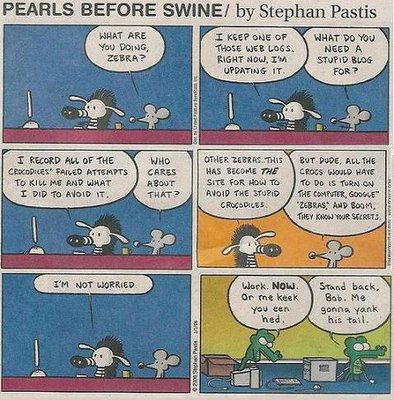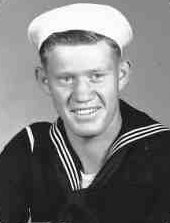Tag… You’re It
May 13th, 2007 by AW1 Tim
Note: This is AW1 Tim’s inaugural post. I played in the same world from the surface, so I can say the “gouge” is good…and it’s a good story from the days of the “Cold War.”
<hr>
I’ll start off this adventure with a story about ASW, anti-submarine warfare. I relate it to you partly because I was a participant, but mostly because it is an example of thinking outside the box. It illustrates what can be accomplished by using your opponent’s philosophy against him. This story took place nearly 30 years ago, but I can remember it quite well.
The Straits of Gibraltar is the western doorway to the Mediterranean Sea. Pretty much everything has to pass through it to reach the Atlantic. Directly above the straits is Spain, and it’s western side holds the Bay of Cadiz, and a small city called Rota. Rota is the home of Eastern Atlantic ASW operations, and the location of Naval Station Rota, where we were based. At that time, I was assigned to VP-10 as a Sensor operator onboard P-3B Orions. Basically, an airborne sonarman. A good job, and one I liked. Rotais also a prime liberty spot, and the setting for many an adventure which will, in due course, see the light of day. But not this day, for there is another tale to tell, and so I must return to the narrative.
Well, the Soviets, our old friends,and to a certain extent, they were that, or, rather, acquaintances, bred of familiarity, were also interested in the area. The only way for them to get a submarine (outside, of course, of their own Black Sea Fleet) into the Med was to transit the straits, and that’s a difficult thing to do undetected, even for our own boats. It’s shallow water, as ocean’s go, and not too wide, and lots of ships overhead. Many an opportunity not only to be found out, but to interact rather rudely and, perchance, catastrophically with other vessels and land forms. Plus everyone’s looking for you. The usual tactic for submarines of all types was to trail some distance behind the carrier (or other target vessel) they were shadowing, and to try and glide in under a larger surface ship, to mask their own noise.
Did I mention the Soviet Trawler? Regardless of the paucity of commercially viable fish stocks, the Soviets had stationed a fishing trawler off the runway at Rota, in international waters. Their purpose to keep tabs on us, casting, as it were, their nets to catch the unwary. Now, It was a given that they were an intelligence-gathering vessel. Their fishing nets were all neatly stored, they never left their anchorage, and there was this small forest of antennas and masts all over the upper works. We knew what theywere, they knew we knew, and we all played the game. So familiar was the fishing trawler to Navy Pilots and Navigators, that it became an unofficial navigational marker. In fact, as a professional courtesy, on many a mission we would drop a care package to those poor souls on our way outbound. A little gift from America to our Soviet Naval Comrades, as it were. We’d take a plastic packing case that a sonobuoy comes in, fill it with a bottle or two of Jack Daniels, some cassette tapes, a couple of adult magazines, and then seal it up. We’d drop it out the sonobuoy launcher on the way by, and they’d send a small boat over to pick it up. They’d wave, we’d wave, and the cold war went on. But I digress.
USS Saratoga was planning on transiting the Straits, and conducting a patrol through the Mediterranean Sea. Problem was, there was this pesky Soviet Echo-II class submarine tailing her, and Saratoga was, naturally, concerned about the situation. Echo II class submarines carried cruise missiles that could well & goodly cause all sorts of mischief to a carrier, ar any other vessel. Saratoga requested that our squadron conduct ASW operations to locate andidentify this submarine so she could determine how best to deal with it. Usually, if you can locate the sub, they’ll back off and try again some other time. At the very least, they don’t like being discovered, because a submarine’s best defense is to remain undetected.
We planned and briefed for a late afternoon launch, and the ASW Ops portion of the mission would be exactly what we trained for. However, there was a problem in that the Soviet Trawler would be easily able to ID our launch, and transfer that information to the Echo-II, who would then lay low until we departed the area. Not unlike smugglers who have someone watching out for the cops. Same idea. What to do, what to do. We needed to locate and ID this submarine, generate as much intel on it as possible, and to try and give Saratoga more time to complete her inchop to the Med. We also didn’t want to tip our hand that we KNEW about the submarine ahead of time. The plan developed thusly:
Our aircraft would depart from Rota and rather than turn south, we’d turn north as though we were headed up the coast to England, following the standard air transit route. Once we got sufficiently up and out of the range of the Soviet sensors, we circled west and out, keeping our distance until we could, at altitude (above 15,000ft) approach the Straits as if we were a commercial aircraft. One of the advantages of the P-3 Orion is that it was, well, derived from a civilian airliner. Therefor, posing as one on radarwasn’t too awfully hard.
Meanwhile, Saratoga had some of it’s ASW folks pull a few sonobuoys from their own stores, and at a specified point, they rolled these off the stern, the drop being sufficient to activate the buoy’s impact sensor and deploy the antenna and hydrophone. For anyone watching, it would look more or less like they were tossing trash overboard. Saratoga radioed us the channels of the bouys, and the order they were dropped, and the spacing, and we dialed them up into our sensor suites, and waited.
The Echo-II, having been given, apparently, the “all clear” from the Trawler, now moved to trail Saratoga into the Straits, maneuvering fairly close aboard, though submerged, to a commercial vessel also heading east. The Echo-II was counting on both the noise and the mass of the civilian ship to mask her transit, but was unaware she was sailing directly into a waiting
line of hydrophones. The hunter had become the hunted.
As we neared the area, being at high altitude we could start to pick up the signal from the sonobuoys at some distance. Within a very short time, there came the unmistakable signature of a Soviet Echo-II class submarine. We were elated. Not only did we have direct acoustic contact with him, but we had his location down to a very narrow area. After contacting the ASW Tactical Support Center onboard Saratoga, it was decided that the best course of action would be to gather as much acoustic intel on the Sovietboat as we could, then light him up with active sonar and try and chase him back out of the straits. In fact, rather than allow him to get through, we determined to try and turn him before he made it in. We did this by dropping a pair of CASS (command activated sonobuoy system) buoys ahead of the submarine and waiting for it to approach them.
At about the extended range of the CASS buoys, we fired off the first ping, and folks, it was like turning on the lights and yelling “Happy Birthday!” at a surprise party. That Echo-II wound his turbines up so high that I had to turn down my headset sound. The sub initiated a hard turn and transited back out to the Atlantic like there was no tomorrow. It was a complete surprise to him, and we made it a little more painful by descending to low altitude and fixing his position with our MAD gear and smoke markers. Bythat I mean that we were so low during that phase of the evolution, that he would have easily heard our own propellers and turbines as we flew overhead. He KNEW we were there.
So, long story short, Saratoga got away into the Mediterranean with quite some distance between her and the trailing boat. We were able to bring a few more crews onto the Echo-II and tracked him around the area for several days before he finally turned north and headed back, his mission foiled. Probably had some serious ‘splainin’ to do when he got home as well. We, on the otherhand, found it difficult to list humility amongst our many virtues at that point. I suspect such has always been the bane of Naval Aircrew, regardless of the era.
The important story, though, is that we were able to exploit the Soviet tactics by turning their stoic allegiance to certain dictats to our own use. We made the Soviet Trawler think that we were doing something else. By spending the time to transit way out and around, we lowered our own on-station time, but kept the ability to stalk our prey by being “downwind” as it were, and approaching from an unexpected quarter. We utilized non-standard stores delivery by having Saratoga deploy the buoys. That allowed us, then, to approach the target while monitoring the pattern, and also saved us time by not having to drop them ourselves. The combined ops of both the CVBG and the VP Squadron allowed us to fully control the ASW environment, and to force the submarine to react to our terms. Had this been an actual war, we would most likely have been able to engage the contact before he was aware of our presence.
AW’s have a motto: We will locate your faintest whispers…..target your slightest movements…..gaze upon the heat of your body…..we will hear your pounding heart in the deepest oceans…..and when you finally become aware of our presence…..we will have already begun your departure…..forever!
We’re good at what we do.
Category: "Sea Stories", History, Military, Navy | 4 Comments »

